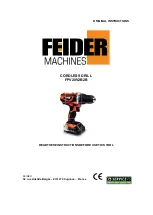
5
English
4. Confirm the direction of bit rotation (Fig.1)
The bit rotates clockwise (viewed from the rear
side) when the reversing switch lever is set to the
“ R” side position. When the lever is set to the “ L”
side position, the bit rotates counterclockwise and
can be used to loosen and remove screws.
5. Adjusting the tightening depth (Fig.2)
Pull the lock sleeve in the direction of arrow to
remove it from the spline installed in the gear
cover. While pulling the lock sleeve and turning it
right and left, adjust the position of locator. Push
the lock sleeve and align the gear cover spline with
the lock sleeve spline.
The lock sleeve can be inserted onto the gear cover
spline and locked.
(1) For hex-head screws:
Mount a hex-head screw on the hex-socket and set
the distance between the sub-stopper end and the
screw head neck to 1–1.5 mm, as shown in
Fig.3
.
(2) For drywall screws:
Mount a drywall screw on the bit, and set the
distance between the sub-stopper end and the screw
head to 1.5–2 mm, as shown in
Fig.4
.
(3) For cross-recessed self-drilling screws:
Mount a self-drilling screw on the bit, and set the
distance between the sub-stopper end and the screw
head bottom to 1–1.5 mm, as shown in
Fig.5
.
6. Mounting the bit
For details, refer to the item “ M ounting and
dismounting the bit” .
MOUNTING AND DISMOUNTING THE HEX-
SOCKET OR THE BIT
1. Dismounting the hex-socket (Fig.6)
(1) While rotating the Sub-Stopper pull it out from the
locator.
(2) Remove the hex-socket, hold it with the opposite
side of bit by hand or vise and pull out the bit with
pliers.
2. Dismounting the bit (Fig.7)
Remove sub-stopper (A) as the same manner of
hex-head socket and remove the bit holder, then
pull out the bit with pliers.
3. Dismounting the bit (Fig.8)
Remove the sub-stopper (C) as the same manner
of hex-head socket and remove the bit holder, then
pull out the bit with pliers.
4. Mounting the hex-socket or the bit
Install the bit in the reverse order to removal.
HOW TO USE THE SCREW DRIVER
1. Switch operation and rotational speed
adjustment
Bit rotational speed can be adjusted between 0–
4000/min (W6V3) or 0–2600/min (W6VA3, W6VB2)
or 0–1700/min (W8VB) varying the degree by which
the trigger sw itch is pulled. Rotational speed
increases as the trigger switch is pulled, and reaches
a maximum speed of 4000/min (W6V3) or 2600/min
(W6VA3, W6VB2) or 1700/min (W8VB) when the
trigger switch is pulled fully.
To facilitate continuous operation, pull the trigger
switch and depress the switch stopper. The switch
will then remain ON even when the finger is released.
By pulling the trigger switch again, the switch
stopper disengages and the switch is turned OFF
when the trigger switch is released.
2. Screw Driver operation
When the switch is turned ON, the motor starts to
run but the hex-socket (or the bit) does not rotate.
Attach the hex-socket to the screw head groove,
and push the Screw Driver against the screw. The
hex-socket then rotates and tightens the screw.
CAUTION
Ensure that the Screw Driver is held truly
perpendicular to the head of the screw.
If held at an angle, the driving force will not be
fully transferred to the screw, and the screw head
and/or hex-socket w ill be dam aged. Hex-socket
rotation stops when pushing force is released.
3. Direction of hex-socket rotation
The hex-socket rotates clockwise (viewed from the
rear side) when the reversing switch lever is set
to the “ R” side position. When the lever is set to
the “ L” side position, the hex-socket rotates counter-
clockwise, and can be used to loosen and remove
screws.
CAUTION
Never change the direction of hex-socket (or bit
holder) rotation w hile the m otor is running. To do
so w ould seriously dam age the m otor. Turn the
pow er sw itch OFF before changing the direction
of hex-socket (or bit holder) rotation.
MAINTENANCE AND INSPECTION
1. Inspecting the hex-socket (or bit)
Since continued use of a worn hex-socket (bit) will
damage screw heads, replace the hexsocket (bit)
with a new one as soon as excessive wear is
noticed.
2. Inspecting the mounting screws
Regularly inspect all mounting screws and ensure
that they are properly tightened. Should any of the
screws be loose, retighten them immediately. Failure
to do so could result in serious hazard.
3. Maintenance of the motor
The motor unit winding is the very “ heart” of the
power tool. Exercise due care to ensure the winding
does not become damaged and/or wet with oil or
water.
4. Inspecting the carbon brushes (Fig.9)
The m otor em ploys carbon brushes w hich are
consumable parts. Since an excessively worn carbon
brush can result in motor trouble, replace the carbon
brushes with new ones having the same carbon
brush No. shown in the figure when they become
worn to or near the “ wear limit” . In addition, always
keep carbon brushes clean and ensure that they
slide freely within the brush holders.
5. Replacing carbon brushes (Fig.10)
Disassembly:
(1) Loosen the three screws, and remove the handle
cover.
(2) Lift the brush holder gently with a screwdriver or
the like, and remove it from the housing while
depressing the carbon brush, as shown in
Fig.9
. Be
careful not to excessively pull the lead wire.
Summary of Contents for W 6V3
Page 32: ...27 ...
Page 34: ...www maquinas maquinas com ...











































